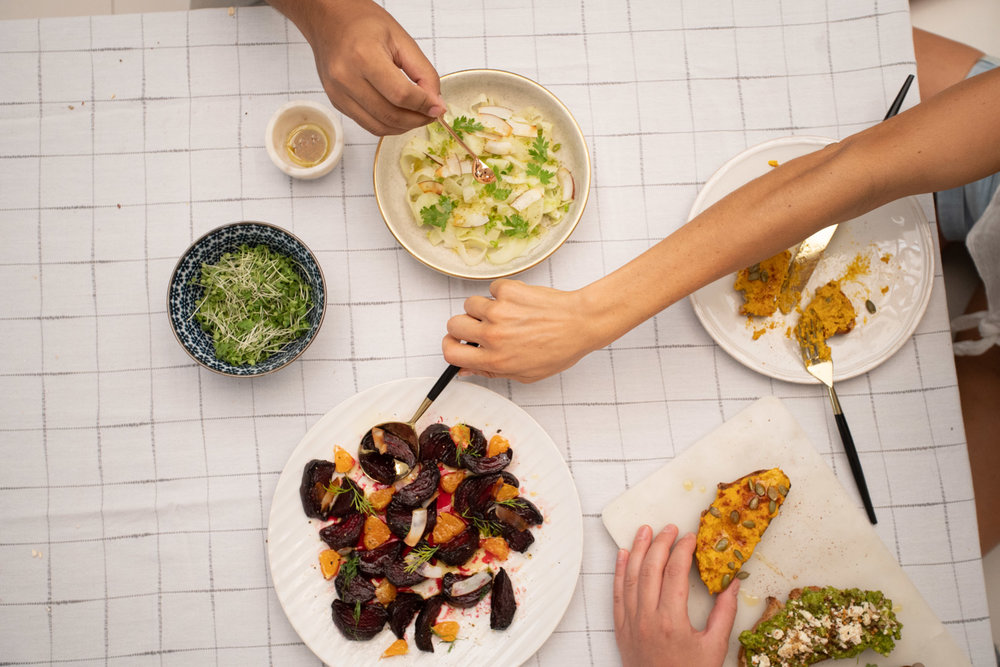Sarah X Hannah Part 1 : Start Eating Mindfully From Today!
This is the first practice we wanted to talk about because it is all about how you eat and think about food, rather than jumping straight in to what you eat.
Mindful eating means eating with awareness and involves paying attention to your body’s signals. This means allowing yourself to eat when you are hungry and knowing to stop when you are satisfied. It includes eating slowly and consciously, tuning into the flavours and sensations you experience. Crucially it also includes noticing your thoughts and feelings around food, and connecting with where your food has come from.
Mindless eating is the opposite of mindful eating. It’s eating in response to something other than hunger. Mindless eating includes not paying attention to your thoughts around food, not connecting with what you are eating, and not noticing your body’s hunger and fullness signals.
There is not one perfect way to eat

Through her Health Coaching, Sarah has learnt to recognise many examples of mindless eating in her clients that are remarkably common and understandable in terms of how they developed, but tend not to serve them in moving towards their health and fitness goals. Some examples that you may resonate with are:
You’re used to eating at set points in the day, even though you’re not necessarily hungry at those times. You eat lunch at 12pm because it’s ‘lunch time’ even though you aren’t really hungry for lunch because you had a late breakfast.
You allow others to dictate your portion size. We all have different appetites, nutritional needs and these will also vary from day to day. But we will often not eat enough for our own needs, or eat beyond the point of fullness, because we didn’t choose that amount of food (like in a restaurant or our work canteen). There’s some food left on your plate, and you don’t want it to go to waste, so you finish it up anyway, even though you are not hungry.
You are a fast eater– you may have always been a fast eater, and consider it just ‘who you are’, but it is pretty difficult to eat mindfully whilst wolfing down your food. You are likely to override your fullness signals, and end up eating too much or feeling unsatisfied afterwards. Most importantly, you can miss out on the enjoyment of savouring a meal!!
You are distracted while eating. You snack while watching TV or scrolling on your phone and lose track of how much you ate or how it even tasted.
You tend to diet- denying your hunger, eating too little or eating ‘diet foods’ which don’t fill you up or satisfy you due to a set of external diet rules is also eating in a way that isn’t really mindful. Do you have foods which are off-limits, or which cause you anxiety when you eat them? Why is that? Part of eating mindfully involves examining your own thoughts and labels.
You don’t consciously choose what you eat– you eat this type of cereal because you have done since you were a child, you always snack on samosas at 4pm because this is what your family has always done- without engaging with how this actually makes you feel.
Overtime, this type of eating can lead to feeling low energy, feeling out of control around food and losing the joy and celebratory relationship that we can have with food.
In our experience, bringing consciousness into choosing and eating food, can make it a lot easier to make positive, lasting changes.
The most important reason to eat more mindfully is that your food is more enjoyable when you eat slowly and savour every mouthful. You truly enjoy and celebrate the food you eat.
Taking time to enjoy each moment is such an important part of living well.
Secondly, you are more likely to eat the right amount, and make good decisions about the right foods for your body when you eat slowly and mindfully. When we are in tune with our bodies, we tend to want to eat a wide variety of foods which nourish us (more on this next week!).
Remember a healthy eating style has room for a wide variety of foods, including foods that are traditionally thought of as ‘unhealthy’. Eat slowly and consciously, no matter what food you are consuming, and take satisfaction from the experience. Whether you are eating a green smoothie or a late night biryani, consciously enjoy each mouthful and notice how your body feels before, during and after eating.
As a nutritionist, Hannah believes that changing eating behaviour can be very challenging because we have spent a great number of years forming a relationship with and around food. Over time certain associations have been made unconsciously with specific emotions, certain foods, activities, and even certain eating practices. When we want to bring about a change in eating behaviour we must realise that we are dealing with issues that may be deep rooted within us. The first step is to understand what is driving your need to change; is it a desire to look good or a desire to be healthy or even a desire to feel good? The next step would be to accept whatever you choose and to start being mindful of what you’re putting into your body, and to identify situations that lead you to make poor dietary choices.
It’s complex- and easier said than done. To help you start eating mindfully from this point forwards, we’ve broken it down into 5 actionable practices.
1. Start the meal with gratitude.
Take 20 seconds to look at the food on your plate and really think about how grateful you are that you have enough to eat, and that you have choice in what you eat.
Try to think about the journey the food has been on, and who might have been involved in that journey, and send gratitude their way, whether it is a farmer, the chef in the kitchen, or your mum!
Appreciate the colours, smells and textures of the food in front of you and smile! This can help you to slow down and savour rather than jump in and wolf down your food.
2. Count
Try counting to help slow you down until you naturally eat slowly. Chewing your food properly is an important part of good digestion and a healthy gut microbiome. Aim to chew your food at least 20-30 times- it will seem like a lot at first, but keep counting and focusing on the experience of eating.
3. Put your fork down between every mouthful.
Just let your hand rest on the table while you consciously focus on the flavour of the food while you chew. Most of us are already finding our next bite before we have even swallowed the food in our mouths. That is actually a distraction from the present moment. Putting your fork down, enjoying the food or focusing on the company of people you might be sharing a meal with can enable you to enjoy the experience more.
Chew, swallow and take a conscious breath before you start preparing your next bite!
4. Notice your thoughts and dismiss unhelpful labels
Sometimes when eating, thoughts pop into our head about whether what we are eating is ‘good’ (like oats or spinach) or ‘bad’ (maybe sweets or chocolate) and this can lead to feelings about ourselves and distort the experience of eating that food. Recognise that these are thoughts around ‘food rules’ and not truths- no food is inherently good or bad, and a healthy, balanced diet has room for a wide variety of different foods.
‘Food rules’ are often ingrained due to the culture of dieting and food shaming that we live in. Acknowledge that and notice these rules for what they are, and instead focus on the experience of eating and the enjoyment it brings. In our experience, when clients ‘tune in’ in this way, they find that they savour those sweets, enjoy them, but are able to stop satisfied, rather than eating the whole packet 🙂
5. No distractions
Try not to eat front of the TV or whilst on social media when dining on your own. This habit can lead to mindless eating- blink and the food is gone! Try setting the table nicely and eat consciously even when alone. When having a meal, just eat – no computer, reading, or scrolling on your phone. Be present with the food and the company you are with if you are sharing a meal. Being present like this can increase that feeling of satisfaction that you get out of eating, and help you to eat the right amount for your specific nutritional needs.
If you can adopt even one or two of these practices from today, you will be moving towards a more conscious and healthy relationship with food itself. For more tips and guidance on eating mindfully, attend one of my mindful eating workshops (all workshops are posted on our events page here) or check our my previous blog post here.

Now here is a chance to put these principles into action- a simple, quick and flavourful salad full of fresh, local produce. Practice the above 5 principles while cooking and eating!
Click through here to our ever-popular beetroot, orange and coconut salad.
As you eat, pay attention to the earthy flavours of the roasted beetroot and how it contrasts with the zesty freshness of the orange. Feel the difference between the textures of the orange and the roasted coconut. Notice the variety of flavours, where you feel them on your tongue, and the magic they create together. Slow it down, chew carefully, and afterwards notice how you feel in your body. Comment below with your feedback!
